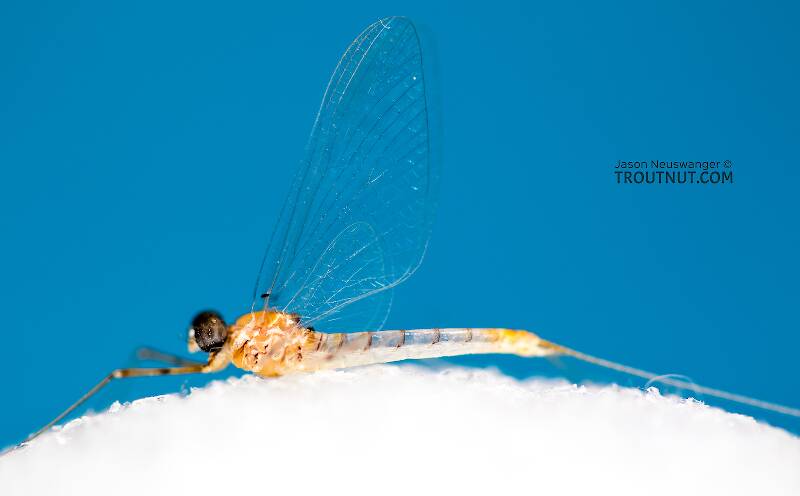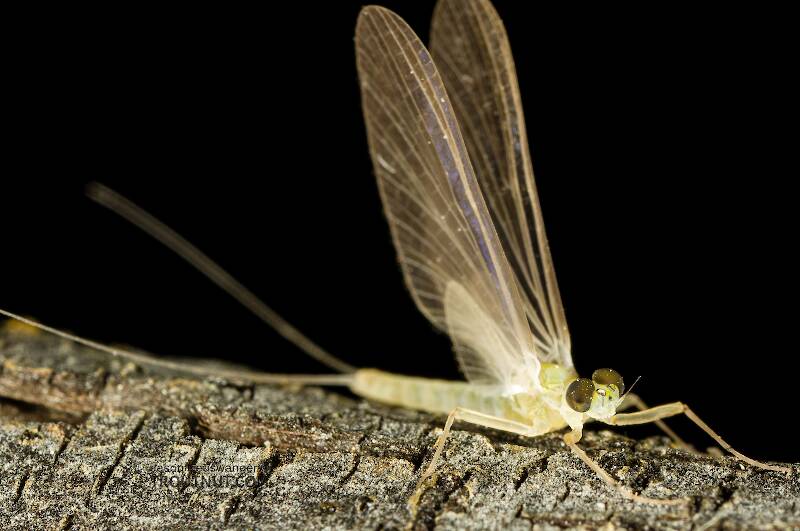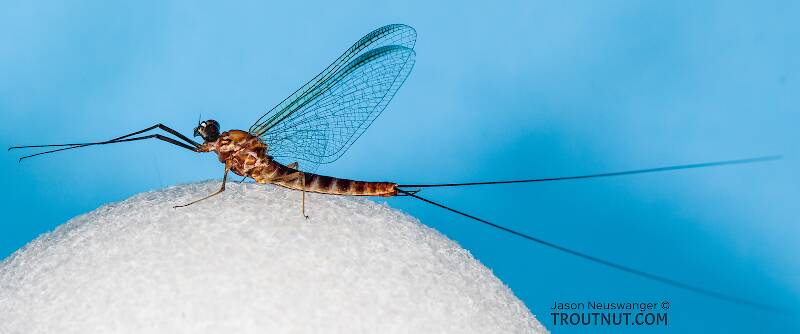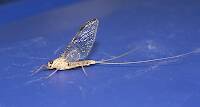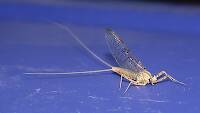
Salmonflies
Pteronarcys californica
The giant Salmonflies of the Western mountains are legendary for their proclivity to elicit consistent dry-fly action and ferocious strikes.
Featured on the forum

This specimen keys pretty easily to Onocosmoecus, and it closely resembles a specimen from Alaska which caddis expert Dave Ruiter recognized as this genus. As with that specimen, the only species in the genus documented in this area is Onocosmoecus unicolor, but Dave suggested for that specimen that there might be multiple not-yet-distinguished species under the unicolor umbrella and it would be best to stick with the genus-level ID. I'm doing the same for this one.

Troutnut is a project started in 2003 by salmonid ecologist Jason "Troutnut" Neuswanger to help anglers and
fly tyers unabashedly embrace the entomological side of the sport. Learn more about Troutnut or
support the project for an enhanced experience here.
This topic is about the Mayfly Family Heptageniidae
Known as the "clinger" mayflies to anglers, a few species of this family can be extremely prolific, with a lot more that aren't. These lesser species account for many of the curious mayflies you find that never seem to associate with a major hatch, let alone a fishable one. Not all heptageniid species are so scarce though; there are superhatches too.Heptageniids can be broken into "groups" of similar genera (based on angling concerns) to help keep track of them. Although many of them are closely related, they are not officially divided in this way by entomologists. Here are the groups:
Stenonema (blotchy wings)
The genus Stenonema, who's Latin name was one of the first etched in the minds of anglers, was for a while largely reclassified into Maccaffertium but has since been reinstated. It includes the March Brown (S. vicarium) and Gray Fox (previously S. fuscum) superhatches.
The Stenonema species are for all practical purposes limited to the East and Midwest.
Former Heptagenia (plain wings)
While Heptagenia has held on to several species, many of its fishable hatches have been moved to the genera Leucrocuta, Nixe, and Ecdyonurus. Some species of Nixe were subsequently moved to Afghanurus. There are many former Heptagenia species across the continent, but few are important to anglers. Of those, more are in the West than in the East.
Epeorus (two-tailed Nymphs, plain wings)
The closely related genera Epeorus and Ironodes are among the only mayflies to have just two tails as nymphs. Good populations can be found in the West, but it's in the East where the mayfly named after the man that brought the dry fly to America can be found, the superhatch Epeorus pleuralis or Quill Gordon.
Rhithrogena (suction cup gills)
The genus Rhithrogena can be identified by the gills of its nymphs. They extend underneath the abdomen in the front and the back. They are very important for early season anglers in the West, but not very often in the East. For western anglers, it's duns are the blotchy winged equivalent of the East's March Brown (Maccaffertium vicarium). Ironically, it is only the Western March Brown that is in the same genus as the English species for which the common name originated.
Cinygmula (horn heads)
The genus Cinygmula is easily distinguished by the nymph's enlarged palpi (mouth parts) that stick out from both sides of their heads like little blunt horns. They rarely produce fishable hatches, and none are of much significance except for a few species, mostly in certain locales of the West.
Example specimens
Quillgordon on Mar 21, 2009March 21st, 2009, 7:08 am EDT
Looking at a recent photo of a possible 'march brown' nymph; this question came to mind!
What factors were involved in the making of the 'maccaffertium/stenacron/stenonema genera?
Can someone give me a link (general explanation, if possible) to explain the distinction of the insect in question.
Qg.
What factors were involved in the making of the 'maccaffertium/stenacron/stenonema genera?
Can someone give me a link (general explanation, if possible) to explain the distinction of the insect in question.
Qg.
Flyfishing is a state of mind! .............. Q.g.
C/R........barbless
C/R........barbless
GONZO on Mar 21, 2009March 21st, 2009, 11:46 am EDT
Hi John,
The "breakup" of the former members of Stenonema did not happen all at once. Here's what I recall about how that process unfolded:
At the time of the publication of the original Hatches (1975), they were clustered in subgeneric groups (the Interpunctatum, Femoratum, and Pulchellum groups). Shortly thereafter, the Interpunctatum group was elevated to comprise the new genus Stenacron. More than twenty years later, the Pulchellum group was elevated to become the Maccaffertium genus. That left the Femoratum group remaining as Stenonema, and species within that group (such as tripunctatum, femoratum, and scitulum) were synonymized under Stenonema femoratum. Stenonema now stands as a "monotypical" genus.
All of these genera/groups share certain traits, such as threadlike 7th gills in the nymphs and "L"-shaped penes in adult males. Among the things that serve to separate them are the shapes of the gills on segments 1-6. These are pointed in Stenacron (the former Interpunctatum group), truncated in Maccaffertium (the former Pulchellum group), and rounded in Stenonema (the former Femoratum group).
That's the best summary that I can offer. I will leave it to professional workers like Konchu to explain why certain distinctions (and the evolutionary relationships that might be inferred from them) warrant the creation of new genera.
PS--The original Hatches (and others) referred to the Femoratum group as the Tripunctatum group. Lewis (1974) referred to this group as the Femoratum group.
The "breakup" of the former members of Stenonema did not happen all at once. Here's what I recall about how that process unfolded:
At the time of the publication of the original Hatches (1975), they were clustered in subgeneric groups (the Interpunctatum, Femoratum, and Pulchellum groups). Shortly thereafter, the Interpunctatum group was elevated to comprise the new genus Stenacron. More than twenty years later, the Pulchellum group was elevated to become the Maccaffertium genus. That left the Femoratum group remaining as Stenonema, and species within that group (such as tripunctatum, femoratum, and scitulum) were synonymized under Stenonema femoratum. Stenonema now stands as a "monotypical" genus.
All of these genera/groups share certain traits, such as threadlike 7th gills in the nymphs and "L"-shaped penes in adult males. Among the things that serve to separate them are the shapes of the gills on segments 1-6. These are pointed in Stenacron (the former Interpunctatum group), truncated in Maccaffertium (the former Pulchellum group), and rounded in Stenonema (the former Femoratum group).
That's the best summary that I can offer. I will leave it to professional workers like Konchu to explain why certain distinctions (and the evolutionary relationships that might be inferred from them) warrant the creation of new genera.
PS--The original Hatches (and others) referred to the Femoratum group as the Tripunctatum group. Lewis (1974) referred to this group as the Femoratum group.
Quillgordon on Mar 21, 2009March 21st, 2009, 10:45 pm EDT
Gonzo,
Very informative as usual. Notice this was a non-caddis question! ...... LOL.
>>>>>>>>>>>>>>>>>>>>>>>>>>>>>>>>>>>>>>>>>>>>>>>>>>>>>>>>
Anglers looking for information on the popular species Stenonema fuscom should know that it has been combined with Maccaffertium vicarium.
>>>>>>>>>>>>>>>>>>>>>>>>>>>>>>>>>>>>>>>>>>>>>>>>>>>>>>>>>>>>>>>>>>
One of the reason I asked this question is because I saw a former question here about the removal of the former 'Stenonema fuscum'( grey fox) as a seperate species! Did I read that correctly ?
Looking at Art Flick's 'streamside Guide' and Schwiebert's 'Matching the Hatch', they both were convinced that they were two different species..... IMO
Schwiebert shows a plate drawing with two distincly different duns, and describes the nymph thorax as 'dark brownish grey' for the march brown; and 'amber molted with brown' on the grey fox. He also mentions they emerge differently when leaving the water.
Art Flick also shows them as two different nymphs on page 121(drawing), and lists them differently in his 'collection dates', which we conducted over a three year period!
So has the current 'scientific community' concluded that Schwiebert and Flick were wrong in their conclusions, or am I interpreting things wrong ?
Just stirring the pot,
Very informative as usual. Notice this was a non-caddis question! ...... LOL.
>>>>>>>>>>>>>>>>>>>>>>>>>>>>>>>>>>>>>>>>>>>>>>>>>>>>>>>>
Anglers looking for information on the popular species Stenonema fuscom should know that it has been combined with Maccaffertium vicarium.
>>>>>>>>>>>>>>>>>>>>>>>>>>>>>>>>>>>>>>>>>>>>>>>>>>>>>>>>>>>>>>>>>>
One of the reason I asked this question is because I saw a former question here about the removal of the former 'Stenonema fuscum'( grey fox) as a seperate species! Did I read that correctly ?
Looking at Art Flick's 'streamside Guide' and Schwiebert's 'Matching the Hatch', they both were convinced that they were two different species..... IMO
Schwiebert shows a plate drawing with two distincly different duns, and describes the nymph thorax as 'dark brownish grey' for the march brown; and 'amber molted with brown' on the grey fox. He also mentions they emerge differently when leaving the water.
Art Flick also shows them as two different nymphs on page 121(drawing), and lists them differently in his 'collection dates', which we conducted over a three year period!
So has the current 'scientific community' concluded that Schwiebert and Flick were wrong in their conclusions, or am I interpreting things wrong ?
Just stirring the pot,
Flyfishing is a state of mind! .............. Q.g.
C/R........barbless
C/R........barbless
GONZO on Mar 22, 2009March 22nd, 2009, 9:20 am EDT
So has the current 'scientific community' concluded that Schwiebert and Flick were wrong in their conclusions....
Yes and no. At the time of Schwiebert and Flick's writings, fuscum and vicarium (and rivulicolum) were generally considered to be separate species by scientific workers. However, questions/doubts about their relationship and about what distinctions were valid for assigning species status existed in the scientific literature. Many early ways of distinguishing between the supposed species (particularly those based on size, color, and markings) were later considered to be invalid. The basic issue is one of assessing variability within a species. When samples are small, or when study and correlation of all of the stages is incomplete, it is difficult to gauge variability.
Such questions are usually resolved as more samples are studied over a wider area and as the rearing of nymphs into adults provides a clearer picture of variability. The differences that Schwiebert and Flick described (and those described by earlier scientific workers) are simply considered to be variations within the same species--often within the same population.
For example, one of the main ways of distinguishing between the nymphs of fuscum and vicarium was an observed difference in the ventral markings at the rear of the abdomen. When Lewis published his assessment of Stenonema in 1974, he mentioned seeing a display assembled by another worker that showed a range of markings that graded progressively from those described for one species to those described for the other. Although they were still treated as separate species in his publication, he commented that the display was "very convincing."
The range of variability in size, color, and markings can be stunning within some mayfly species. (Hexagenia limbata is a great example of this.) When extensive populations of a given species have extended emergence periods, it is not unusual for them to become smaller and lighter in color as the emergence draws on. It is also not unusual to see changes in some aspects of emergence as water levels or temperatures change during that period. Although these differences can sometimes be significant in our fly-fishing, we should be careful about assigning too much significance to them from a taxonomic perspective.
Quillgordon on Mar 22, 2009March 22nd, 2009, 10:53 pm EDT
Gonzo,
I understand what you are saying. I guess they had to make a distinction between 'Synonomizing' the two, or creating a 'Sub-species'. Would that be an accurate statement?
I see it mentioned here at this link... @ Sublevels & Taxon
http://www.troutnut.com/article/6/10/taxonomic-changes-and-obscure-levels
>>>>>>>>>>>>>>>>>>>>>>>>>>>>>>>>>>>>>>>>>>>>>>>>>>>>>>>>>>>>>>
There are three common types of changes:
Taxa may be moved to different taxonomic levels. For example, Drunella and Attenella and several other former subgenera of Ephemerella were all recently moved up to the level of genus in the same family, Ephemerellidae.
Subtaxa may be moved into different taxa. Most often, a species is moved from one genus to another closely related genus. This happens frequently to the prolific little mayflies of the Baetidae family.
Taxa are found to be synonyms of other taxa, originally described as different species because a wide degree of individual variation gave their discoverers the wrong impression.
The third type of change is the most common in the mayfly species of importance to fly anglers. Some of the most famous species have been synonymized with others. For example:
Ephemerella rotunda is now a synonym of Ephemerella invaria.
Baetis vagans is now a synonym of Baetis tricaudatus.
Stenonema fuscom is now a synonym of Maccaffertium vicarium.
Sometimes there are differences between the taxa that get synonymized, but they aren't great enough to warrant separate species. In fact, even the precise definition of a species (and just about every other taxonomic level) is a fuzzy area.
I understand what you are saying. I guess they had to make a distinction between 'Synonomizing' the two, or creating a 'Sub-species'. Would that be an accurate statement?
I see it mentioned here at this link... @ Sublevels & Taxon
http://www.troutnut.com/article/6/10/taxonomic-changes-and-obscure-levels
>>>>>>>>>>>>>>>>>>>>>>>>>>>>>>>>>>>>>>>>>>>>>>>>>>>>>>>>>>>>>>
There are three common types of changes:
Taxa may be moved to different taxonomic levels. For example, Drunella and Attenella and several other former subgenera of Ephemerella were all recently moved up to the level of genus in the same family, Ephemerellidae.
Subtaxa may be moved into different taxa. Most often, a species is moved from one genus to another closely related genus. This happens frequently to the prolific little mayflies of the Baetidae family.
Taxa are found to be synonyms of other taxa, originally described as different species because a wide degree of individual variation gave their discoverers the wrong impression.
The third type of change is the most common in the mayfly species of importance to fly anglers. Some of the most famous species have been synonymized with others. For example:
Ephemerella rotunda is now a synonym of Ephemerella invaria.
Baetis vagans is now a synonym of Baetis tricaudatus.
Stenonema fuscom is now a synonym of Maccaffertium vicarium.
Sometimes there are differences between the taxa that get synonymized, but they aren't great enough to warrant separate species. In fact, even the precise definition of a species (and just about every other taxonomic level) is a fuzzy area.
Flyfishing is a state of mind! .............. Q.g.
C/R........barbless
C/R........barbless
GONZO on Mar 23, 2009March 23rd, 2009, 1:26 am EDT
Yes. Linnaean taxonomy is a useful tool for organizing and understanding evolutionary relationships, but things do not always fit neatly into the boxes we create for them. Current DNA "barcoding" projects may help to clarify many of these relationships, especially as scientists come to better understand the information it provides.
Quillgordon on Mar 23, 2009March 23rd, 2009, 4:56 am EDT
Since most of us here are not 'entomologists we tend to use 'common names' for the insects we fish(tye)/encounter.
I notice the 'common name' "grey fox" is listed under the gerera Heptagenia and Strenacron and not under Maccaffertium; where the march brown is placed. If that is the case, then the grey fox Flick and
Schwiebert were citing would then indeed be a different species than the march brown listed under Maccaffertium.
Just my thoughts!
I notice the 'common name' "grey fox" is listed under the gerera Heptagenia and Strenacron and not under Maccaffertium; where the march brown is placed. If that is the case, then the grey fox Flick and
Schwiebert were citing would then indeed be a different species than the march brown listed under Maccaffertium.
Just my thoughts!
Flyfishing is a state of mind! .............. Q.g.
C/R........barbless
C/R........barbless
GONZO on Mar 23, 2009March 23rd, 2009, 5:52 am EDT
Grey Fox, Ginger Quill, March Brown, and American March Brown are among the fly-fishing "common names" that have been applied to M. vicarium (or current synonyms thereof) in American fly-fishing literature, but some of these have also been applied to other Maccaffertium species and to species of Rhithrogena, Heptagenia, Stenacron, and many other genera/species.
There is absolutely no standard by which fly fishers apply common names except usage. Many of these names derive from fly patterns rather than insects or have been adopted from European patterns/insects. Any insect that somewhat resembles a fly pattern or European insect might have had that name assigned to it by fly fishers. Hence, we use Blue-Winged Olive as a common name for about 50 different species in widely different genera.
Jason hasn't attempted to discover and list all of the possible common names that fly fishers use to describe mayflies in fly-fishing literature or in locales around the country, nor should he. Because so many names are applied to so many different mayflies, that effort would probably just contribute to further confusion.
Stark, et al. have given standardized common names to many of the North American stonefly genera/species, but these names are not widely known or used by most fly fishers. To the best of my knowledge, there has been no such effort to standardize common names for mayfly species. Even if there was such an effort, it would probably have little effect on the enormous confusion that is created by the use of relatively meaningless fly-fishing common names.
Over time, popularity of usage tends to have a consolidating effect on nonstandard common names. British fly fishers are much less confused by common names applied to their mayflies than their North American counterparts often are. This is partly due to a longer history of usage, though they also have significantly fewer species to get confused about. Some newer and more specific common names are gaining popularity on this side of the pond. Names like Trico/Trike and Hex have more specific and reliable meanings because they derive from scientific names. These have largely replaced earlier names like Tiny White-Winged Black, Pale Olive Dun, or Angler's Curse for Tricorythodes species and names like Michigan Mayfly, Great Olive-Winged Drake, Great Lead-Winged Drake, Canadian Soldier, Fishfly, Shadfly, and the absurd Michigan Caddis for Hexagenia species.
Still, this consolidation of usage is a long, slow process. Although I understand the frustration and resistance associated with using scientific names, they remain the best way to try to clarify what we might mean when we use names like BWO.
There is absolutely no standard by which fly fishers apply common names except usage. Many of these names derive from fly patterns rather than insects or have been adopted from European patterns/insects. Any insect that somewhat resembles a fly pattern or European insect might have had that name assigned to it by fly fishers. Hence, we use Blue-Winged Olive as a common name for about 50 different species in widely different genera.
Jason hasn't attempted to discover and list all of the possible common names that fly fishers use to describe mayflies in fly-fishing literature or in locales around the country, nor should he. Because so many names are applied to so many different mayflies, that effort would probably just contribute to further confusion.
Stark, et al. have given standardized common names to many of the North American stonefly genera/species, but these names are not widely known or used by most fly fishers. To the best of my knowledge, there has been no such effort to standardize common names for mayfly species. Even if there was such an effort, it would probably have little effect on the enormous confusion that is created by the use of relatively meaningless fly-fishing common names.
Over time, popularity of usage tends to have a consolidating effect on nonstandard common names. British fly fishers are much less confused by common names applied to their mayflies than their North American counterparts often are. This is partly due to a longer history of usage, though they also have significantly fewer species to get confused about. Some newer and more specific common names are gaining popularity on this side of the pond. Names like Trico/Trike and Hex have more specific and reliable meanings because they derive from scientific names. These have largely replaced earlier names like Tiny White-Winged Black, Pale Olive Dun, or Angler's Curse for Tricorythodes species and names like Michigan Mayfly, Great Olive-Winged Drake, Great Lead-Winged Drake, Canadian Soldier, Fishfly, Shadfly, and the absurd Michigan Caddis for Hexagenia species.
Still, this consolidation of usage is a long, slow process. Although I understand the frustration and resistance associated with using scientific names, they remain the best way to try to clarify what we might mean when we use names like BWO.
Creno on Mar 23, 2009March 23rd, 2009, 11:05 am EDT
I would like to concur with GONZO - while we are all fisherpersons, some of us have pursued entomology to the degree that taxonomic names have become more descriptive than common names. I have watched anglers try and deal with taxonomy for over 30 years now (and I grew up fishing the Michigan caddis all night long)and there is a continuing trend by anglers towards picking up (and often converting) the latin to common terms - e.g. tricho and hex. We all find it more useful over time.
A note on the term - synonymy. Q.g. and this site have listed a definition as:
Taxa are found to be synonyms of other taxa, originally described as different species because a wide degree of individual variation gave their discoverers the wrong impression.
However, there are lots of reasons to create a synonym other than natural variation. The "technical" definition of a synonym is:
"Each of two or more names of the same rank used to denote the same taxonomic taxon."
Sometimes species described as distinct are determined to be the same because of individual variation. But probably more often the synonymy is the result of a mis-identification of a species as new when it is already known under another name. Gonzo mentioned the efforts of the DNA specialists to work out these subtle differences. From what I have seen (at least with the caddis) the DNA folks are finding as many questions about several cryptic species within a single species as with several "species" actually being just one.
creno
A note on the term - synonymy. Q.g. and this site have listed a definition as:
Taxa are found to be synonyms of other taxa, originally described as different species because a wide degree of individual variation gave their discoverers the wrong impression.
However, there are lots of reasons to create a synonym other than natural variation. The "technical" definition of a synonym is:
"Each of two or more names of the same rank used to denote the same taxonomic taxon."
Sometimes species described as distinct are determined to be the same because of individual variation. But probably more often the synonymy is the result of a mis-identification of a species as new when it is already known under another name. Gonzo mentioned the efforts of the DNA specialists to work out these subtle differences. From what I have seen (at least with the caddis) the DNA folks are finding as many questions about several cryptic species within a single species as with several "species" actually being just one.
creno
GONZO on Mar 23, 2009March 23rd, 2009, 11:29 am EDT
Hi Creno! It's nice to be able chat with you again.
Creno on Mar 23, 2009March 23rd, 2009, 1:47 pm EDT
It is always fun to read the posts and I have been checking in off and on. Just not much going on with caddis for me to say much. Besides, you seem more than capable of keeping them up to date on all the groups.
GONZO on Mar 23, 2009March 23rd, 2009, 2:50 pm EDT
Thanks, but aside from the online community thing, I think we all come here to learn and share what we have learned. It is the interesting mix of dedicated fly fishers, fly tiers, bug geeks, and scientists that makes Jason's site special. And I have plenty of caddisfly questions to ask now that my ski boots are off. :)
Quillgordon on Mar 24, 2009March 24th, 2009, 1:32 am EDT
Fellow Troutnuts,
My post was meant to stir a discussion of the findings of Art Flick & E. Schwiebert about their findings concerning those insects (common names) namely their march brown and grey fox; and the present day findings that the former 'Stenonema fuscum' is the same insect.
It appears that the use of 'common names' in any discussion is Taboo. I am well aware of the confusion that can exist when using common names, but the insects in question were specific insects denoted by 'well respected' fishers; namely Flick & Schwiebert.
I quoted the common names as listed under the genera Heptagenia and Stenacron because they were listed there. It was not a criticism of the website in any way, I was just quoting what I saw!
It's disappointing to see other posters criticize others especially when they want an open forum, not just a forum of entomologists!
My post was meant to stir a discussion of the findings of Art Flick & E. Schwiebert about their findings concerning those insects (common names) namely their march brown and grey fox; and the present day findings that the former 'Stenonema fuscum' is the same insect.
It appears that the use of 'common names' in any discussion is Taboo. I am well aware of the confusion that can exist when using common names, but the insects in question were specific insects denoted by 'well respected' fishers; namely Flick & Schwiebert.
I quoted the common names as listed under the genera Heptagenia and Stenacron because they were listed there. It was not a criticism of the website in any way, I was just quoting what I saw!
It's disappointing to see other posters criticize others especially when they want an open forum, not just a forum of entomologists!
Flyfishing is a state of mind! .............. Q.g.
C/R........barbless
C/R........barbless
Taxon on Mar 24, 2009March 24th, 2009, 4:17 am EDT
John-
Although I had not yet dipped my oar in this thread, I have been following it with much interest. And, as far as I can see, everyone has treated both you and your ideas with respect, even though they may not necessarily agree with them.
I find it interesting that you cite the writings of Ernest Schwiebert, while (seemingly) promoting use of common names for insects, as I credit "Ernie", probably more than any other fly fishing writer, with having championed use of scientific names for insect identification purposes among those in the fly fishing community.
Incidentally, in his posthumously published book, Nymphs Volume I: The Mayflies, where he discussed Stenonema fuscum on pages 376-379, "Ernie" appeared to continue believing Stenonema fuscum (Grey Fox) to be a different species than Stenonema vicarium (March Brown), notwithstanding taxonomists' rationale for combining them, and for renaming most of the Stenonema species as Maccaffertium species. And, after having witnessed another of his firmly held taxonomic beliefs reinstated recently, I am somewhat less inclined to dismiss any of his firmly held beliefs, based simply on his advanced degrees not having been in entomology.
Although I had not yet dipped my oar in this thread, I have been following it with much interest. And, as far as I can see, everyone has treated both you and your ideas with respect, even though they may not necessarily agree with them.
I find it interesting that you cite the writings of Ernest Schwiebert, while (seemingly) promoting use of common names for insects, as I credit "Ernie", probably more than any other fly fishing writer, with having championed use of scientific names for insect identification purposes among those in the fly fishing community.
Incidentally, in his posthumously published book, Nymphs Volume I: The Mayflies, where he discussed Stenonema fuscum on pages 376-379, "Ernie" appeared to continue believing Stenonema fuscum (Grey Fox) to be a different species than Stenonema vicarium (March Brown), notwithstanding taxonomists' rationale for combining them, and for renaming most of the Stenonema species as Maccaffertium species. And, after having witnessed another of his firmly held taxonomic beliefs reinstated recently, I am somewhat less inclined to dismiss any of his firmly held beliefs, based simply on his advanced degrees not having been in entomology.
GONZO on Mar 24, 2009March 24th, 2009, 9:43 am EDT
John,
I'm sorry if you took anything that I had to say negatively. I am not an entomologist, and I was only trying to answer your questions to the best of my ability.
Perhaps it would be better if Schwiebert spoke for himself. In the Appendix to the book you mention (Matching the Hatch), he had this to say about common ("popular") names:
I'm sorry if you took anything that I had to say negatively. I am not an entomologist, and I was only trying to answer your questions to the best of my ability.
Perhaps it would be better if Schwiebert spoke for himself. In the Appendix to the book you mention (Matching the Hatch), he had this to say about common ("popular") names:
There are so many for each species that it has got to the point where anglers cannot converse intelligently with others when they fish away from home. The reason is rather simple. One man's Green Drake is another man's Shad fly, depending upon the region in which he lives. If the man from the Beaverkill and the man from Penn's Creek both called the hatch Ephemera guttulata, they would be on less boggy ground. The biologists faced this confusion long before it filtered down to the angler, and the result was the Latin designation used by all. There is no way to sugar-coat these scientific names and still avoid the confusion that surrounds local and popular names.
Quick Reply
Related Discussions
Topic
Replies
Last Reply
12
Apr 11, 2007
by Taxon
by Taxon
Re: Anybody know more about Maccaffertium terminatum?
In the Mayfly Species Stenonema terminatum by Troutnut
In the Mayfly Species Stenonema terminatum by Troutnut
3
Jun 11, 2007
by Konchu
by Konchu
Re: The boys were back in town, Chapter 4: new digs, new waters, new fish! 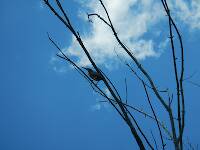


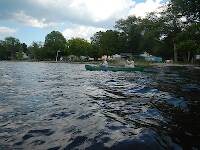

In the Photography Board by Jmd123
+ 15





In the Photography Board by Jmd123
8
Aug 8, 2019
by Jmd123
by Jmd123
1
Apr 18, 2007
by Troutnut
by Troutnut


